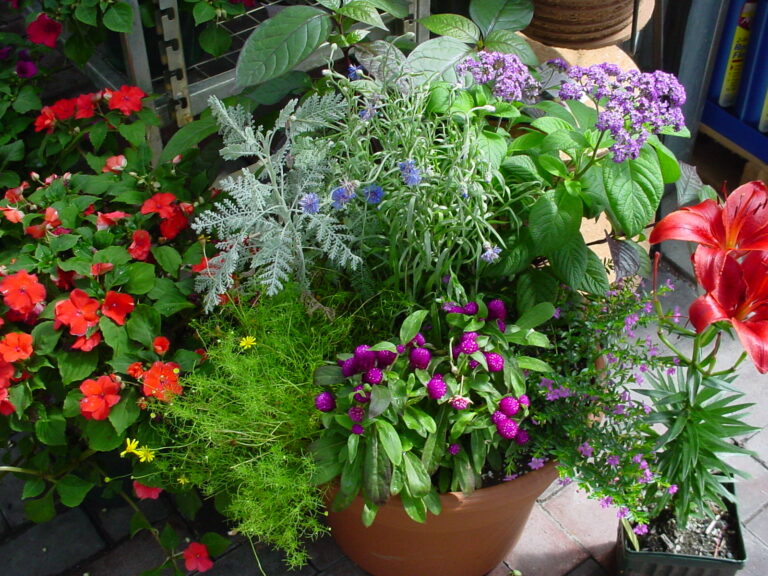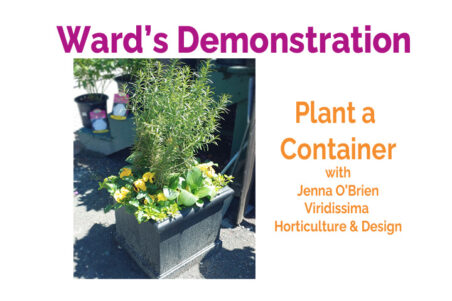Planting a Container

Maybe you’d like to try a new flower combination but starting up a “full-sized specialty garden” sounds too expensive and then, ugh, what if you don’t like it?
Scroll down for a link to video of Jenna O’Brien, Viridissima Horticulture & Design, putting together a container for us in 2021.
For something more manageable, consider a few containers to add new definition to your sidewalk, deck or patio. Anything that holds soil and drains can be a container–let your imagination go! You can do a series where each pot has plants of similar colors but different shapes, all the same arrangement or unique specimens to balance each unique pot. Sun-loving plants need a minimum of 6 hours of sun but for shade lovers that can be too much (3 to 5 hours direct sun is better). So choose your plant combinations wisely. Beyond that here are some basic guidelines for success:
Choose a container that can hold the plant.
Annuals can handle crowding as long as you water and fertilize regularly. Large annuals, like cannas, elephant’s ears, or dahlias need a pot that is 20 inches high and from 18 to 24 inches in diameter, but there will still be room for a few small flowers to trail out around the edges. For a smaller centerpiece (say tuberous begonia, coleus or small trio of impatiens, begonias or marigolds) with trailing ivy or sweet potato vine, you can use a container 10 to 12 inches deep and across.
Plant in lightweight potting soil.
Your container plants will need to stay moist but not waterlogged. Potting soil mixes are formulated to retain moisture while still draining well. Garden soil is usually too high in clay content and will hold too much water. Remember that your container needs to drain. You can put screening material over the hole in the bottom so that soil does not run out with the water.
Establish a watering and fertilizing routine.
The real trick to beautiful healthy containers is monitoring their moisture. A daily dose of water will be required in hot sunny weather and maybe even two doses—one in the morning and again at midday—during extreme heat. The kind of container you choose will make a difference. Small terra cotta pots holding a quart of soil will dry out quicker than a large plastic pot with 2 gallons of soil.
How you water matters.
Water slowly and gently allowing the water to reach all the soil in the pot and to begin draining out the bottom. Be sure to empty the saucer if you have one. Roots left in a puddle of water will rot.
Feed your plantings.
To manage the fertilizing, mix a slow-release fertilizer into the surface of the soil at planting time. This fertilizes your plants every time you water for over 3 months. With the slow-release system, you’ll know your soil has the nutrients to keep your plants healthy. For fuller blooms, add a blossom-booster fertilizer (10-50-10 ratio) in your watering can every 2 weeks. When watering, nip off the spent flowers to prevent them from going to seed. This will encourage new growth and flowers.
So, try something a little different this season without spending a fortune!
Jenna O’Brien of Viridissima Horticulture & Design puts an edible container together in this video:
Download this post as a PDF that also includes Jenna’s additional tips and tricks for her edible container:
Containers: Basic Tips and More
Our Summer Garden Advice
By mid-summer, perennial gardens can start to look overgrown, annual flowers begin to fade, and bugs may be munching on your vegetables.
Summer Articles